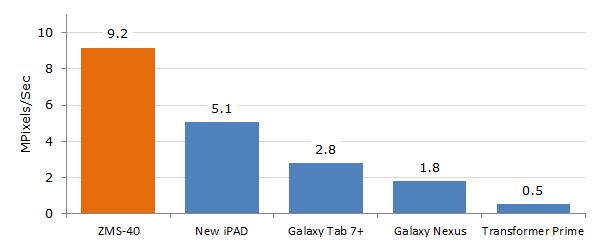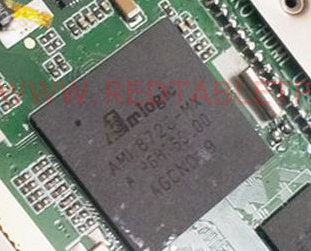In February, Texas Instruments compared the browser rendering performance of its OMAP 5 platform to the Nvidia Tegra 3, and the benchmark results showed OMAP 5 was twice as fast @ 800 MHz than the Tegra 3 @ 1.3 GHz. Today, they’ve uploaded a video showing the 3D performance a tablet based on OMAP 5 (and PowerVR SGX 544-MP GPU) against a market-leading tablet (I guess it’s the Apple iPad 3 with PowerVR SGX 543 GPU) using GLBenchmark 2.5 with the following setup: 1080p resolution. On-screen and off-screen tests were conducted to compensate for the “Vysnc Limited” scenarios. (24bpp) 16bit depth tests to better represent high-end game content Power saving mode disabled and device connected to a power source. No background tasks and airplane mode “on.” The on-screen results show 38 fps for the OMAP 5 vs 34 fps for the other platform, or a 12% performance boost. Off-screen results […]
Linaro Android Puts Stock Android To Shame on TI Pandaboard (OMAP4430)
The team at Linaro has done an amazing job at optimizing Android 4.0 for ARM and Bernhard Rosenkränzer, Android Engineer at Linaro among other things, has put all those optimizations together to showcase a demo at Linaro Connect Q2.2012 in Hong Kong with 2 pandaboards: One running Stock Android 4.0.4, the one released by Google (AOSP) One running Linaro Android 4.0.4 Both hardware, android version and benchmark software (oxBench) are the same, and the results are quite amazing with Android Linaro achieving about 60 fps in all 0xBenchmark tests (OpenGL Cube, OpenGL Blending, OpenGL Fog and Flying Teapot) whereas Android stock achieving 30 fps. They selected a benchmark tool that is mainly CPU bound, as they cannot optimize the GPU code since they can only access binary blobs. Apparently, most of the improvements were possible thanks to toolchain and code optimization (to be able to build) such as using gcc […]
Linaro 12.05 Release with Kernel 3.4 and Android 4.0.4
Linaro has just released version 12.05 based on Linux Kernel 3.4 and Android 4.0.4. This release provides lots of improvement for Origen (Samsung Exynos 4) on Android, further work has been done on big.LITTLE processing and ARMv8 work appears to have started for Ubuntu and Debian. armel vs armhf benchmarks show a massive improvement (up to 15x) when using armhf for povray (3D rendering),. but for most other tests, there is little improvement, and in some rare cases armhf is slightly slower than armel. Here are the highlights of the release: Android Created a stable Google hangout build for Origen Updated DS-5 and gator daemon to 5.10 Stress tests from big.LITTLE testing have been integrated into LAVA Completed big.LITTLE Android tasks Monkeyrunner tests for automating common Android usage have been integrated into LAVA Ordered a new power measurement device from National Instruments Updated and Origen 3.4 rc7 Completed Android HAL […]
Linaro 12.04 Release with Kernel 3.4 and Android 4.0.4
Linaro has just released version 12.04 based on Linux Kernel 3.4-rc3 and Android 4.0.4_r1.1. This release already provides Ubuntu 12.04 LTS images for Pandaboard, Snowball, Origen and Versatile Express, and all community builds (nano, ALIP…) are based on Ubuntu Precise Pangolin as well. This should provide significant performance boosted compared to Ubuntu 11.10 thanks to hard-float support and other optimization (See Phoronix Benchmarks). A lot of work since to have gone into big.LITTLE implementation, HTML5 is now supported in Firefox, and it seems Linaro is still working on ARMv6 as they provided VP8 optimizations and improved the toolchain for this architecture. Here are the highlights of the release: Android Finished Snowball Multimedia enablement. Updated all builds to AOSP ICS 4.0.4_r1.1. Switched all builds to 4.7. Updated base toolchain components MPFR and GMP. Ported htop to Android. Ported stressapptest to Android for big.LITTLE Testing. Implemented and ran weekly big.LITTLE tests. Integrated […]
Ziilabs MandelMark Benchmark Shows ZMS-40 GPU Compute Performance is 18 Times Faster than Nvidia Tegra 3
Ziilabs released comparative GPU compute benchmark results for its ZMS-40 stem cells processor and made available its MandelMark floating point benchmark for Android 4.0 as an apk file. Since Ziilabs is using its own benchmark tool, which they released as a binary but did not open source, the results should be taken with a grain of salt. GPU Compute (aka GPGPU – General Purpose computing on GPU) is a technique to use the GPU to perform complex calculations usually performed by the CPU. MandelMark benchmark visualizes the solutions to the Mandelbrot to measure the floating point performance of mobile processors. Ziilabs compared their ZMS-40 Quad Core Cortex A9 processor with 96 stemcell cores to the following competitors: IPAD 3 – Apple A5X processor with a quad-core PowerVR SGX543MP4 GPU Galaxy Tab 7+ – Samsung Exynos 4210 processor with a quad-core ARM Mali-400 GPU Galaxy Nexus – TI OMAP 4460 processor […]
AMLogic Announces AML8726-MX Dual Core Cortex A9 Processor
Amlogic announced the availability of the AML8726-MX, a SoC based on a dual-core ARM Cortex-A9 MPCore processor clocked at 1.5 GHz with a Mali-400 MP GPU. It is the successor of the similarly named AML8726-M with a single core Cortex A9 @ 1 GHz. The company explains this SoC is particularly suitable for Over The Top (OTT) delivery, 3D Gaming and other Internet applications and targets the tablet, set-top-box and smart-TV markets. AMLogic AML8726-MX include 10/100/1000 Ethernet, 2x USB interfaces, 3-in-1 Card Reader support, Analog and digital video outputs, LVDS and T-CON (Timing Controller) with backlight control, digital video and camera interfaces. Wi-Fi is supported via external chipsets. Here are the highlights of the AML8726-MX family provided by AMLogic: A dual-core Cortex-A9 processor achieving over 7500 DMIPS of performance Direct to panel connection with advanced scaling, de-interlacing and picture quality enhancement Industry leading power management technology to extend battery life […]
Linaro 12.03 Release with Kernel 3.3-rc3
Linaro has just released version 12.03 based on Linux Kernel 3.3-rc3 and Android 4.0.3. Among the key points, hardware video decode in now supported in Origen (Android), Android runs in A15/A7 platforms, libav AAC optimization provides about 2x performance improvement and QEMU supports Samsung Exynos 4240 and Calxeda Highbank (work done upstream). Here are the highlights of the release: Android Linaro Android has support for DS-5 version 5.9. Hardware accelerated Multimedia is now integrated on Origen. EEMBC, denbench and coremark have been ported to Android and are running in LAVA. android.net ConnectivityManager unit tests have been built and integrated in all builds. Hardware decode of H264 and MPEG4, 1080P and 30 FPS is enabled on Origen. Origen now has 1080p HDMI Graphics and Video Support. Android runs on A15, A7 and A15/A7 fast models. ARM’s big.LITTLE has been tested running Android using a set of unit tests. Kernels of prebuilt […]
Cross-compiling the ARM Linux Kernel in Ubuntu 12.04 LTS
Yesterday I installed Ubuntu 12.04 ‘Precise’ Beta 1 in Virtual Box to give it a try (I could not manage to have HUD working btw), and today, I’ve noticed an article entitled “Ubuntu 12.04 ‘precise’ and cross compilation of ARM kernels” explaining how to build Linaro ARM kernel in Ubuntu 12.04. So I’ve decided to give it a try, especially it seems straightforward. I followed the instructions in the aforementioned link, it basically worked except I had to install dpkg-dev package that also installed the build essentials (gcc, g++, etc…) and use sudo for some commands. You’ll notice the name change for the ARM gcc toolchain as it now uses hard-float by default which seems to provide quite a boost in performance for the Pandaboard. Here are the steps I followed: Install the ARM GCC cross compiler and the development package of dpkg:
|
1 |
sudo apt-get install gcc-arm-linux-gnueabihf dpkg-dev |
Retrieve the kernel source:
|
1 |
apt-get source linux-source-3.2.0 |
Install […]






